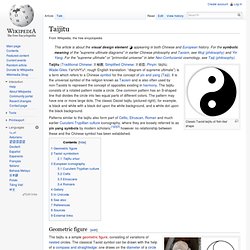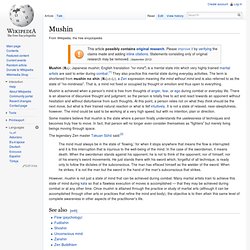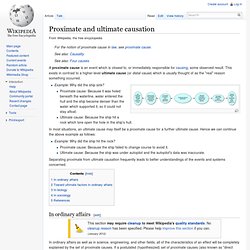

Taijitu. Classic Taoist taijitu of 'fish-like' shape Patterns similar to the taijitu also form part of Celtic, Etruscan, Roman and much earlier Cucuteni-Trypillian culture iconography, where they are loosely referred to as yin yang symbols by modern scholars;[1][2][3] however no relationship between these and the Chinese symbol has been established.

Geometric figure[edit] Yin yang grown in nature Drawing the taijitu (animation) The taijitu is a simple geometric figure, consisting of variations of nested circles. It is additionally connected to the swastika symbol, using the S-shaped line dividing the two portions of the circle and drawing it both vertically as well as horizontally, then by changing the soft arcing lines to be more angular, results in a swastika.
Taoist symbolism[edit] The term taijitu (literally "diagram of the supreme ultimate") is, in modern times, commonly used to mean the simple "divided circle" form ( Taijitu shuo[edit] Non-polar (wuji) and yet Supreme Polarity (taiji)! Lojong. Lojong (Tib.

བློ་སྦྱོང་,Wylie: blo sbyong) is a mind training practice in the Tibetan Buddhist tradition based on a set of aphorisms formulated in Tibet in the 12th century by Geshe Chekhawa. The practice involves refining and purifying one's motivations and attitudes. The fifty-nine or so slogans that form the root text of the mind training practice are designed as a set of antidotes to undesired mental habits that cause suffering. They contain both methods to expand one's viewpoint towards absolute bodhicitta, such as "Find the consciousness you had before you were born" and "Treat everything you perceive as a dream", and methods for relating to the world in a more constructive way with relative bodhicitta, such as "Be grateful to everyone" and "When everything goes wrong, treat disaster as a way to wake up.
" History of the practice[edit] Atiśa journeyed to Sumatra and studied with Dharmarakṣita for twelve years. Geshe Chekhawa is claimed to have cured leprosy with mind training. 1. 2. Mushin. Mushin (無心; Japanese mushin; English translation "no mind") is a mental state into which very highly trained martial artists are said to enter during combat.[1] They also practice this mental state during everyday activities.

The term is shortened from mushin no shin (無心の心), a Zen expression meaning the mind without mind and is also referred to as the state of "no-mindness". That is, a mind not fixed or occupied by thought or emotion and thus open to everything. Some masters believe that mushin is the state where a person finally understands the uselessness of techniques and becomes truly free to move. In fact, that person will no longer even consider themselves as "fighters" but merely living beings moving through space. The legendary Zen master Takuan Sōhō said:[2] Neidan and Waidan: Taoist Alchemy. The Golden Elixir ▶ Taoist Alchemy Fabrizio Pregadio Background Liu Haichan, a Taoist immortal associated with several alchemical traditions Taoist alchemy aims to afford an understanding of how the cosmos and the human being are related to the highest principle, the Dao.

Practitioners rise through the hierarchy of the constituents of being by "fulfilling" (Chin. jin or liao, two words also denoting "thorough knowledge") the nature and properties of each stage. Historical and literary sources (including poetry) provide many important details on Taoist alchemy, but the majority of sources is found in the Taoist Canon (Daozang), the largest collection of Taoist texts. Modern study of Taoist alchemy began in the twentieth century, after the Canon was reprinted and made widely available. Although the underlying doctrines remained unchanged, Chinese alchemy went through a complex and not yet entirely understood development along its twenty centuries of documented history. Doctrines History . . . Proximate and ultimate causation. A proximate cause is an event which is closest to, or immediately responsible for causing, some observed result.

This exists in contrast to a higher-level ultimate cause (or distal cause) which is usually thought of as the "real" reason something occurred. Example: Why did the ship sink? Proximate cause: Because it was holed beneath the waterline, water entered the hull and the ship became denser than the water which supported it, so it could not stay afloat.Ultimate cause: Because the ship hit a rock which tore open the hole in the ship's hull.
In most situations, an ultimate cause may itself be a proximate cause for a further ultimate cause. Hence we can continue the above example as follows: Example: Why did the ship hit the rock? Separating proximate from ultimate causation frequently leads to better understandings of the events and systems concerned. In ordinary affairs[edit] The set of direct factors (of an effect) has a number of known properties; some are the following: 1. 2. 3.